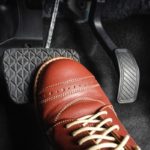1. Avoid frequent hard braking
Most women, especially new drivers, tend to have this habit when driving a car. However, constantly braking hard can put more stress on the braking system, causing the brake discs and pads to wear out faster. In addition, the heat generated during this process can significantly reduce the lifespan of the brakes.
To reduce the negative impact, we need to observe, predict traffic situations, and brake from a distance.
2. Overloading the car with too many items
Women always have countless things to carry, from essential personal belongings to unnecessary items.
Remember, the total weight of the car increases, which makes the brakes have to exert more pressure to bring the car to a stop. In addition, if there are too many things in the car, especially near the steering wheel, it will unintentionally create obstacles during the driving process.

3. Resting the left foot on the brake pedal
Although this is a quite dangerous habit, in reality, it is very common. This can lead to accidentally braking while driving normally, resulting in unnecessary use of the brakes.
Furthermore, this habit can cause us to accidentally step on both the brake and accelerator pedals in some cases of distraction. Therefore, women should remember not to use the left foot when controlling automatic transmission cars. In the case of driving a manual transmission car, women should place their left foot on the clutch pedal.
4. Not changing the brake fluid regularly
Women tend to overlook checking, maintaining, and changing the brake fluid on a regular basis compared to men. However, there is one thing you need to know, maintaining this habit can potentially cause damage to the brake lines.
The old brake fluid attracts moisture, which can cause corrosion to the master cylinder, brake lines, and pistons. This consequence will reduce the effectiveness of the brakes, and even cause a complete brake failure. To protect these components, remember to change the brake fluid once a year.
5. Engaging the handbrake before the car has fully stopped
Engaging the handbrake before the car has fully stopped will cause the braking force to act on the rear wheels, resulting in wheel skidding and loss of control. The reason is that the handbrake is not designed to stop the car while it is moving, but rather to keep it still when fully stopped.
However, due to inertia, many women make this mistake.
6. Not releasing the handbrake while the car is moving
This will keep the brake pads and brake calipers in close contact with the brake discs, creating a very large friction that can cause the brake calipers to overheat and catch fire.
In addition, not releasing the handbrake can also damage the sensors attached to this component, such as the anti-lock braking system (ABS). The worst consequence in this case is the possibility of generating high heat, causing the brake fluid to boil, resulting in a complete loss of braking power.
However, nowadays, some new car models will signal by turning on a warning light on the center dashboard to remind the driver when encountering such situations. Therefore, in any case, women should pay close attention and minimize the occurrence of this harmful habit.
Wishing all women safe driving!
According to Family & Society






































